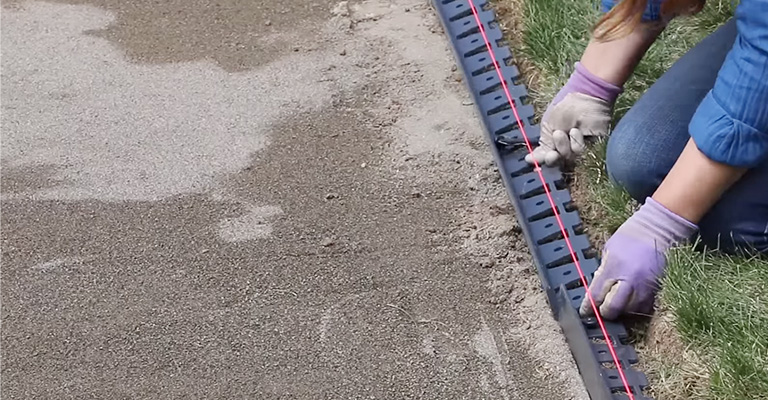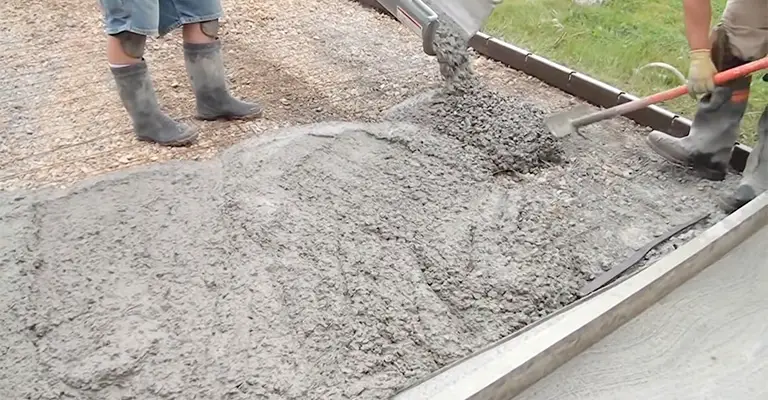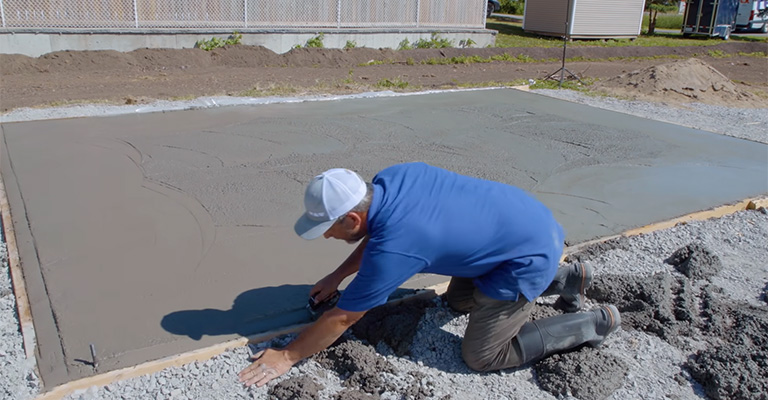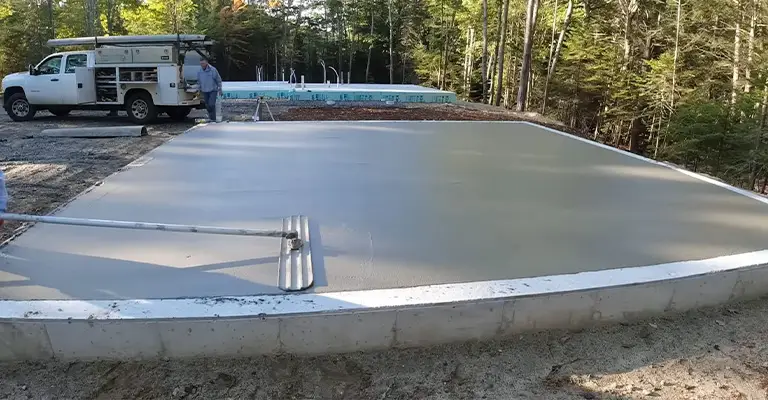When we think about covering a grassy area with concrete, it might sound like a cool idea. But there’s more to it than meets the eye! Pouring concrete over grass isn’t as straightforward as it seems.
It involves a bunch of things to think about, like how nature and building stuff work together, and how to make sure the concrete surface stays strong and doesn’t cause problems.
Let’s dive into this topic and find out why turning green grass into gray concrete needs careful thinking and planning. So, can you pour concrete over grass?
It is possible to pour concrete over grass, but it is not recommended. Several reasons make it unwise to pour concrete directly over grass.
Technically, you could do that, but there are better ways to protect your lawn and set a structure.
The purpose of this guide is to explain why pouring concrete over grass can cause problems-and to suggest better alternatives.
Can You Pour Concrete Over Grass?
Putting concrete over grass is technically possible, but it’s not a good idea. It is imperative to lay concrete on an even, firm, and dry foundation in order to maintain its tensile strength.
Concrete will likely crack over time as a result of moisture being channeled into it by grass and soil. Concrete is also not ideal for drainage reasons.
When you don’t properly prepare grass or soil for concrete, water may pool, damaging your concrete and possibly even causing stagnant water to collect underneath your outdoor living structures after a heavy rain.
The cost of repairing a concrete foundation can reach $25 per square foot. In the event that your foundation is built directly over grass, you’ll have to hire a concrete repair contractor to fix the damage.
How to Pour Concrete Over Grass For a Foundation?
If you want to replace grass with soil for a patio, walkway, or foundation, you need to prepare the area beforehand. You should follow these steps if you are planning to build an outdoor living structure over grass:
- Make sure you dig at least 2 to 3 inches into the soil.
- Any debris, such as branches and roots, should be removed.
- Add two inches of sand or gravel to the ground.
- Using a compacting tool, press it down firmly.
- In addition to laying a concrete foundation, you can also hire a contractor to help with concrete driveways or patios.
- These types of foundations will work well with fast-drying, frost-protected, slab-on-grade, and self-leveling concrete.
Why You Shouldn’t Pour A Concrete Slab Over Grass

Concrete may seem strong, but if it is not properly prepared, it will crack much earlier than expected and leave concrete remains behind.
Here are some reasons why you shouldn’t pour a concrete slab over grass without preparing it first:
Uneven Foundations
Subsidence is caused by decaying grass beneath the concrete slab. As a result, any foundations in close proximity will begin to sink.
The movement of walls and floors caused by subsidence can result in cracks in buildings and destabilize them.
Grass Regrowth
If you leave roots under your slab, they may re-grow through cracks in the concrete.
Although grass cannot crack concrete itself, it can squeeze its way through tiny cracks in the slab and create a much bigger split, even though it may not be strong enough to crack the concrete itself.
Drainage Issues
It is possible for slabs to sink and crack if concrete is poured directly onto soil and grass without adequate drainage.
Due to concrete’s imperviousness, water cannot drain through it and your lawn will become waterlogged.
The water will be unable to move anywhere in winter, but in summer it will evaporate, so it won’t be an issue as much as in summer.
If your lawn and garden are smelling bad, it’s probably because of stagnant water.
Can You Lay Concrete Over Dirt?

Technically, you can do that, but most types of concrete won’t benefit from it. In order to keep concrete dry and allow water to drain underneath, you should place a layer of gravel or sand on top of the dirt.
When you lay concrete over dirt, you may end up with a foundation that cracks or is unstable after just a few months or years, as opposed to a slab of concrete that lasts 10 or more years.
Will Concrete Kill Grass?
Three days is all it takes for concrete to kill grass.
Grass thrives in soil with a pH level between 6 and 7, in most climates, just like any other plant. Grass becomes far more alkaline when concrete is used.
It’s because concrete contains limestone, or calcium carbonate. As a result of its neutralizing properties, it is sometimes used to reduce acidity in soils, such as underneath pine trees where grass is hard to grow.
Minerals, organic matter, and water make up soil, which is a living organism. In the event you attempt to re-grow grass in that area later, long-term exposure to concrete can permanently damage soil microbial activity.
What’s the Best Base for Pouring Concrete?
For the reasons outlined above, gravel and sand bases are both ideal. Fine rocks compact down and sit firmly to provide a solid foundation for concrete.
As well as allowing adequate drainage through the soil, they prevent pools of water from forming.
What Type Of Concrete Will Work Best On Grass?

The best type of concrete to use over grass is quick-drying concrete (that dries within 24 hours). It is better to choose a concrete that only needs to be mixed with water than one that needs to be mixed with several steps.
A good mix of water, rocks, sand, and concrete will last longer with high-quality concrete, even if it costs more than low-quality concrete.
A good concrete brand is Holcim, CEMEX, or CRH America, or you can contact a concrete contractor.
Disposing of Concrete on Grass
It is also possible to find yourself in a situation where concrete has been spilled on grass accidentally by you (or a contractor). The following information will help you understand what’s going on:
- Grass will not necessarily die if concrete or concrete dust are spilled on it.
- A shovel should be used to remove wet concrete immediately.
- New concrete structures should be okay with grass growing around them.
Dig four inches deep before the concrete hardens, if you spill a lot of concrete on grass and you can’t remove it all with a shovel.
It is best to start over from scratch. Water, fertilizer, and grass seed should be laid down. Does this seem disheartening to you? That’s fine.
It is possible, however, to prevent serious damage to the soil in this area by taking swift action. It can be difficult for nearby soil and grass to grow if there is a large patch of “dead” soil without microbial activity.
When Is It Acceptable To Pour Concrete Over Grass?
It may be easier to lay your concrete slab over grass if you need to finish your patio area or shed base quickly.
In spite of the fact that there is no guarantee that laying slabs straight over grass won’t cause issues in the future, the following tips and reasons may help.
At least six inches of concrete should be poured. If you add a thick layer of concrete, grass will have a much harder time working its way up and causing problems.
Regularly fill any cracks that appear in the concrete.
Pouring concrete directly onto grass shouldn’t cause you any problems if you intend to remove it in the near future.
Final Words
Despite its low cost and versatility, concrete will last you for years to come. You can pour it almost anywhere, even on grass.
Pour concrete over grass to create a walkway or mower preventative you’ve always wanted, even if it requires a little work.








